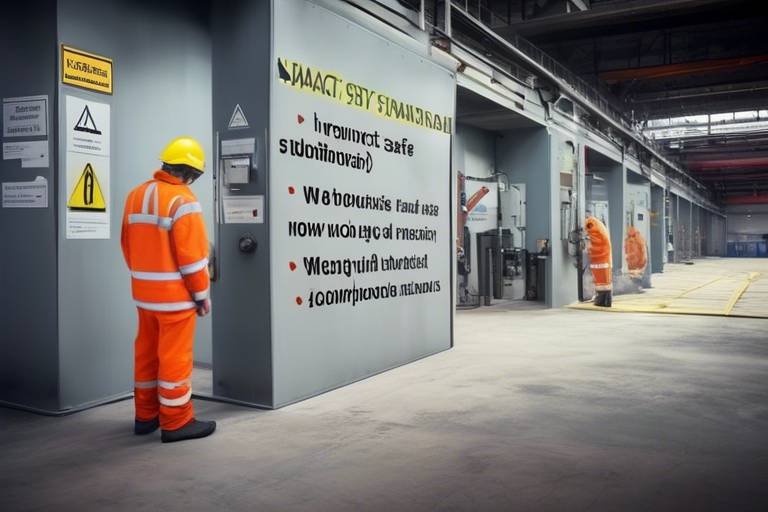Safety Measures: Influencing and Influenced by Human Behavior
In today's fast-paced world, safety measures have become more critical than ever. They are not just about rules and regulations; they represent a complex interplay between human behavior and the protocols designed to protect us. Imagine walking into a construction site without any safety gear or guidelines—sounds reckless, right? This scenario underscores the importance of safety measures and how they shape our actions. However, it's equally fascinating to consider how our behaviors can influence the effectiveness of these safety protocols. Understanding this relationship is essential for creating safer environments, whether at work, home, or in public spaces.
At the heart of this dynamic is the psychology of safety compliance. People often comply with safety measures based on a range of psychological factors, including their motivations, perceptions, and the influence of social norms. For instance, when individuals perceive safety protocols as beneficial, they are more likely to adhere to them. On the flip side, if they see these measures as unnecessary or burdensome, compliance can dwindle. This push and pull between perception and action illustrates the intricate dance between safety measures and human behavior.
Moreover, behavioral economics plays a significant role in understanding safety practices. It helps us decipher how people make decisions regarding safety. For example, when provided with incentives—be it financial rewards or recognition—individuals may be more inclined to follow safety protocols. However, biases and irrational decision-making can sometimes cloud judgment, leading to unsafe practices. The challenge lies in leveraging economic principles to enhance compliance while addressing these biases effectively.
To dive deeper into this topic, we can explore the various incentives for safe behavior. These incentives can be categorized into two main types: intrinsic and extrinsic. Intrinsic motivation stems from personal values and beliefs, encouraging individuals to prioritize safety from within. On the other hand, extrinsic rewards, such as bonuses or public acknowledgment, can serve as powerful motivators. Both types of incentives can significantly impact safety adherence, but the key is to find a balance that resonates with individuals.
However, it's important to recognize the barriers to safety compliance. Complacency often creeps in, especially in environments where safety measures are taken for granted. Additionally, a lack of training or misinformation can create significant obstacles. Imagine a worker who believes they are following safety protocols but is misinformed about the correct procedure. This scenario highlights the necessity of ongoing education and awareness to combat these barriers effectively.
Effective training is crucial in fostering safe behavior. Comprehensive safety training programs not only equip individuals with the necessary knowledge but also enhance their awareness and compliance. Different types of training methods, such as hands-on workshops, online courses, and simulations, cater to various learning styles and needs. Evaluating the effectiveness of these training programs is vital for continuous improvement. By assessing training outcomes and ensuring ongoing compliance with safety measures, organizations can create a culture of safety that resonates with everyone involved.
The impact of organizational culture on safety cannot be overstated. A strong safety culture fosters an environment where compliance is not just expected but embraced. Leadership plays a pivotal role in shaping this culture. When leaders model safe behaviors and prioritize safety in their decision-making, it sets a powerful example for others to follow. Moreover, engaging employees in safety initiatives fosters a sense of ownership and responsibility, making them active participants in creating a safer workplace.
In conclusion, the interplay between safety measures and human behavior is complex yet fascinating. By understanding the psychological factors, leveraging behavioral economics, and fostering a strong safety culture, we can enhance compliance and ultimately create safer environments for everyone. After all, safety is not just a set of rules; it's a shared responsibility that requires the active participation of all individuals.
- What are safety measures? Safety measures are protocols and guidelines designed to protect individuals from harm and ensure a safe environment.
- How do psychological factors influence safety compliance? Psychological factors such as motivation, perception, and social norms significantly impact whether individuals adhere to safety measures.
- What role does training play in safety behavior? Training equips individuals with the knowledge and skills necessary to understand and comply with safety protocols, enhancing overall safety awareness.
- How can organizations foster a strong safety culture? Organizations can foster a strong safety culture by prioritizing safety in leadership, engaging employees in safety initiatives, and providing ongoing training and support.

The Psychology of Safety Compliance
Understanding the psychological factors that drive individuals to comply with safety measures is essential for any organization aiming to enhance its safety protocols. The way people perceive risks, the motivations behind their actions, and the influence of social norms play a pivotal role in determining whether safety measures are followed. Have you ever noticed how people tend to follow rules more diligently when they believe others are watching? This phenomenon can be explained through social psychology, where the presence of peers can significantly influence behavior.
One of the key elements in safety compliance is the concept of perceived risk. When individuals feel that a situation is dangerous, they are more likely to comply with safety measures. However, if they perceive the risk as low, they might disregard safety protocols. This highlights the importance of effective communication in conveying the actual risks associated with certain behaviors or environments. For instance, a construction site might seem safe to a worker who has been there for years, but without proper reminders and training, complacency can set in, leading to dangerous outcomes.
Another crucial aspect is motivation. People are driven by various factors, both intrinsic and extrinsic. Intrinsic motivation comes from within; it’s about personal values and beliefs. When employees believe in the importance of safety, they are more likely to adhere to protocols. On the other hand, extrinsic motivation involves external rewards, such as recognition or bonuses. Organizations can leverage both types of motivation to foster a culture of safety.
Furthermore, social norms play a significant role in shaping behavior. When safety compliance is viewed as a norm within a group, individuals are more likely to follow suit. This is where leadership becomes crucial. Leaders who prioritize safety and model safe behaviors can create an environment where safety is not just a requirement but a shared value among all employees. A strong safety culture can be built when everyone, from the top down, is engaged in promoting safety.
In summary, the psychology of safety compliance is a complex interplay of risk perception, motivation, and social influence. By understanding these psychological factors, organizations can develop more effective safety protocols that resonate with their employees. This understanding can lead to a significant reduction in workplace accidents, ultimately protecting both employees and the organization as a whole. What strategies can your organization implement to enhance safety compliance? The answers may lie in the psychology of your workforce.
- What is the importance of understanding psychology in safety compliance?
Understanding psychology helps organizations tailor safety measures that resonate with employees, leading to better adherence and reduced accidents. - How can social norms influence safety behavior?
When safety compliance is viewed as a norm, individuals are more likely to follow safety protocols, especially if they see peers adhering to them. - What role does motivation play in safety compliance?
Both intrinsic and extrinsic motivations are crucial; fostering a culture of safety enhances intrinsic motivation, while rewards can encourage compliance.

Behavioral Economics in Safety Practices
When we think about safety, we often picture hard hats, safety goggles, and strict protocols. But what if I told you that the way we approach safety is deeply intertwined with the principles of behavioral economics? This fascinating field examines how psychological factors influence our decision-making processes, particularly in the context of safety practices. Understanding these elements can help organizations create more effective safety protocols that resonate with employees on a personal level.
At the heart of behavioral economics is the idea that our decisions are not always rational. In fact, they are often swayed by biases and emotions. For instance, when it comes to safety measures, individuals might underestimate risks due to optimism bias, believing that accidents won't happen to them. This is where the role of incentives becomes crucial. By understanding what motivates people, organizations can design strategies that encourage safer behaviors.
One of the key insights from behavioral economics is that people respond differently to various types of incentives. For example, intrinsic motivators such as personal values and beliefs can drive individuals to adhere to safety protocols. When employees believe in the importance of safety, they are more likely to comply willingly. On the other hand, extrinsic rewards—like bonuses, recognition, or even simple praise—can also play a significant role in promoting safe behavior. Imagine working in an environment where safety is not just a requirement but a celebrated achievement; this shift in perspective can lead to a profound change in how safety is perceived and practiced.
However, it's essential to recognize that not all incentives are created equal. Some may resonate more with certain individuals than others. For instance, while one employee might be motivated by a financial bonus, another may find recognition in a company-wide meeting to be more impactful. This highlights the importance of tailoring safety programs to fit the diverse motivations of the workforce.
Moreover, behavioral economics teaches us about the concept of loss aversion, which suggests that people prefer to avoid losses rather than acquiring equivalent gains. In a safety context, this means that emphasizing the potential losses associated with unsafe behavior—such as accidents, injuries, and even job loss—can be more effective than merely highlighting the benefits of safe practices. By framing safety compliance in terms of avoiding negative outcomes, organizations can create a compelling case for adherence to safety measures.
To further illustrate the impact of behavioral economics on safety practices, consider the following table that outlines various incentives and their potential effects on employee behavior:
| Type of Incentive | Description | Potential Impact |
|---|---|---|
| Intrinsic Motivation | Personal values and beliefs driving safety compliance. | Higher engagement and commitment to safety. |
| Extrinsic Rewards | Bonuses, recognition, and tangible incentives. | Increased compliance through external validation. |
| Loss Aversion | Framing safety in terms of avoiding negative outcomes. | Stronger motivation to adhere to safety protocols. |
In conclusion, integrating behavioral economics into safety practices can significantly enhance compliance and overall workplace safety. By understanding the psychological factors that influence decisions, organizations can develop targeted strategies that not only promote adherence to safety measures but also foster a culture of safety that resonates with every employee. So, the next time you think about safety, remember that it’s not just about the rules; it’s about understanding the human behavior behind those rules.

Incentives for Safe Behavior
When it comes to promoting safety in the workplace, understanding the is crucial. Safety measures can often feel like just another set of rules to follow, but when incentives are properly integrated, they can transform compliance into a culture of safety. Imagine a workplace where safety is not just a requirement but a shared value—this is where incentives play a pivotal role.
Incentives can be categorized into two main types: intrinsic and extrinsic. Intrinsic motivation stems from within the individual. It includes personal values, beliefs, and the satisfaction that comes from knowing you’re contributing to a safer environment. For instance, an employee might feel a sense of pride in ensuring their coworkers return home safe and sound at the end of the day. This internal drive can be incredibly powerful, often leading to a more profound commitment to safety protocols.
On the other hand, extrinsic rewards are tangible incentives provided by the organization. These can include bonuses, recognition programs, or even simple thank-you notes from management. For example, a company might implement a monthly safety award for the team that demonstrates the best safety practices. This kind of recognition not only boosts morale but also encourages others to adopt safer behaviors. A well-structured reward system can create a competitive yet collaborative atmosphere where everyone strives to uphold safety standards.
Furthermore, the effectiveness of these incentives often depends on how they are communicated and integrated into the organizational culture. Companies should ensure that employees understand the benefits of safe behavior—not just for themselves but for their colleagues and the organization as a whole. For instance, a simple poster highlighting the success of a safety initiative can serve as a constant reminder of the importance of compliance and the rewards associated with it.
To illustrate this, consider the following table that outlines some common incentives and their potential impact on safety behavior:
| Incentive Type | Description | Potential Impact |
|---|---|---|
| Intrinsic | Personal satisfaction from contributing to a safe workplace | Increased employee engagement and commitment to safety |
| Extrinsic | Bonuses, awards, and recognition programs | Boosted morale and motivation to adhere to safety protocols |
| Peer Recognition | Encouraging team members to acknowledge each other's safe practices | Strengthened team dynamics and collective responsibility |
In conclusion, a blend of intrinsic and extrinsic incentives can significantly enhance safe behavior in the workplace. By fostering a culture that values safety, organizations not only protect their employees but also create a more productive and harmonious work environment. After all, when people feel valued and recognized for their efforts, they’re more likely to go above and beyond to ensure safety protocols are followed. So, how does your organization incentivize safe behavior? Are you ready to take your safety measures to the next level?
- What are intrinsic and extrinsic incentives? Intrinsic incentives are internal motivators such as personal values, while extrinsic incentives are external rewards like bonuses and recognition.
- How can organizations effectively implement safety incentives? Organizations should clearly communicate the benefits of safety and recognize safe behavior through structured reward systems.
- Why is a culture of safety important? A strong safety culture promotes compliance, reduces accidents, and fosters a sense of ownership among employees.

Intrinsic Motivation
When we talk about , we're diving into the heart of what drives individuals to adhere to safety measures without needing external rewards. It’s like the difference between being told to clean your room and wanting to do it because you enjoy a tidy space. This internal drive is crucial for fostering a culture of safety in any organization. But what exactly fuels this motivation? It often stems from personal values, beliefs, and a genuine concern for oneself and others.
Consider the feeling of accomplishment when someone successfully identifies a potential hazard and takes action to mitigate it. This sense of ownership not only enhances personal satisfaction but also reinforces the importance of safety within the workplace. Individuals who believe in the value of safety are more likely to engage in safe practices, not just for compliance but because they truly care about the outcomes.
Furthermore, fostering a culture of safety can significantly enhance intrinsic motivation. When employees feel that their contributions to safety are valued and recognized, they are more likely to take pride in their actions. This can be achieved through:
- Open Communication: Encouraging dialogue about safety concerns allows employees to express their thoughts and ideas freely.
- Empowerment: Giving employees the authority to make decisions regarding safety fosters a sense of responsibility.
- Recognition: Acknowledging and celebrating safe behaviors can reinforce their importance and encourage others to follow suit.
Moreover, intrinsic motivation is often linked to the concept of self-efficacy, which is the belief in one’s ability to succeed in specific situations. When individuals feel confident in their skills and knowledge related to safety practices, they are more likely to comply with safety measures. This is why comprehensive training programs that not only inform but also empower employees can lead to a significant increase in safety compliance.
In summary, intrinsic motivation plays a pivotal role in promoting adherence to safety measures. By nurturing a culture that values safety, encourages open dialogue, and empowers employees, organizations can tap into this powerful motivator. When individuals are driven by internal values, the commitment to safety becomes a natural part of their behavior, leading to a safer and more productive workplace.
- What is intrinsic motivation?
Intrinsic motivation refers to the internal drive that compels individuals to engage in activities for their own sake, rather than for external rewards.
- How can organizations foster intrinsic motivation for safety?
Organizations can foster intrinsic motivation by promoting open communication, empowering employees, and recognizing safe behaviors.
- Why is intrinsic motivation important in safety compliance?
Intrinsic motivation leads to a deeper commitment to safety practices, as individuals are driven by personal values and beliefs rather than just compliance.

Extrinsic Rewards
When we talk about safety compliance, it’s essential to recognize the power of . These are the tangible incentives that organizations can offer to motivate employees to adhere to safety protocols. Think of extrinsic rewards as the shiny carrots dangling in front of a horse; they can be incredibly effective in guiding behavior. In a world where safety is paramount, understanding how to leverage these rewards can lead to a significant reduction in workplace accidents.
Extrinsic rewards can take many forms, ranging from financial bonuses to recognition programs. For instance, a company might implement a safety bonus system where employees who consistently follow safety protocols receive a monetary reward at the end of the quarter. This not only encourages compliance but also fosters a culture of safety. Additionally, recognition can come in the form of awards or public acknowledgment during company meetings, which can boost morale and encourage others to follow suit.
However, it’s crucial to structure these rewards effectively. A poorly designed incentive program can lead to unintended consequences, such as employees cutting corners to meet safety targets just to earn a bonus. Therefore, organizations must ensure that their extrinsic reward systems promote genuine safety compliance rather than just the appearance of it. For example, a comprehensive safety program might include the following components:
| Type of Reward | Description |
|---|---|
| Monetary Bonuses | Financial incentives for meeting safety targets. |
| Recognition Programs | Acknowledgment of safe practices through awards or certificates. |
| Gift Vouchers | Vouchers for stores or experiences as rewards for safe behavior. |
Moreover, the effectiveness of extrinsic rewards can be enhanced when they are combined with intrinsic motivators. When employees feel valued and recognized for their efforts, they are more likely to internalize the importance of safety. This dual approach can create a robust safety culture where compliance is not just about the rewards but also about a genuine commitment to maintaining a safe work environment.
In conclusion, extrinsic rewards are a powerful tool in promoting safety compliance. When implemented thoughtfully, they can lead to a more engaged workforce that prioritizes safety. However, organizations must remain vigilant in designing these programs to ensure they foster a culture of safety rather than mere compliance.
- What are extrinsic rewards? Extrinsic rewards are tangible incentives provided to employees to encourage specific behaviors, such as safety compliance.
- How do extrinsic rewards affect safety behavior? They can motivate employees to adhere to safety protocols by providing financial bonuses, recognition, or other incentives.
- Can extrinsic rewards lead to negative behaviors? Yes, if not designed properly, they can encourage employees to prioritize rewards over genuine safety practices.
- How can organizations effectively implement extrinsic rewards? By creating a balanced reward system that includes both extrinsic and intrinsic motivators, organizations can foster a culture of safety.

Barriers to Safety Compliance
When it comes to ensuring safety in any environment, understanding the barriers to compliance is crucial. These barriers can often act like invisible walls, preventing individuals from adhering to safety measures that are designed to protect them. One of the most significant barriers is complacency. It’s easy to fall into a routine where safety protocols seem unnecessary, especially if no incidents have occurred in a while. This mindset can lead to a dangerous sense of invulnerability, where individuals believe that accidents won't happen to them. However, history has shown us that complacency can be a silent killer.
Another major barrier is the lack of training. Without proper training, employees may not fully understand the importance of safety measures or how to implement them effectively. Imagine trying to drive a car without ever having learned the rules of the road; it’s a recipe for disaster. Similarly, when workers lack the knowledge of safety protocols, they are more likely to overlook them, putting themselves and others at risk.
Misinformation also plays a pivotal role in hindering safety compliance. In today’s digital age, where information spreads rapidly, it’s not uncommon for myths and misconceptions about safety practices to circulate. For instance, if workers believe that certain safety gear is unnecessary or uncomfortable, they may choose to forgo it altogether. This choice can lead to increased accidents and injuries. To combat this, organizations need to provide clear, accurate, and consistent information about safety protocols, ensuring everyone is on the same page.
Additionally, there are often systemic barriers within organizations that can impede safety compliance. These can include inadequate resources, lack of management support, or insufficient time allocated for safety training. When safety is not prioritized at the organizational level, it sends a message to employees that it is not essential. This can create a culture where safety is viewed as an afterthought rather than a fundamental aspect of the workplace.
To illustrate these barriers, consider the following table that outlines some common obstacles and their potential impacts:
| Barrier | Description | Impact on Compliance |
|---|---|---|
| Complacency | A false sense of security due to no recent incidents. | Increased risk-taking behavior. |
| Lack of Training | Insufficient knowledge of safety protocols. | Failure to implement safety measures correctly. |
| Misinformation | Spread of myths regarding safety practices. | Increased likelihood of unsafe practices. |
| Systemic Barriers | Inadequate resources and management support. | Safety seen as a low priority. |
Addressing these barriers requires a concerted effort from both management and employees. By fostering a culture of safety, providing comprehensive training, and ensuring clear communication, organizations can significantly enhance compliance with safety measures. After all, safety is not just a set of rules; it's a mindset that needs to be cultivated and nurtured.
- What are some common barriers to safety compliance? Complacency, lack of training, misinformation, and systemic barriers are some of the most common challenges.
- How can organizations improve safety compliance? By fostering a strong safety culture, providing adequate training, and ensuring clear communication about safety protocols.
- Why is training important for safety compliance? Training equips employees with the knowledge and skills necessary to adhere to safety measures effectively.
- What role does management play in promoting safety? Management sets the tone for safety culture and provides the necessary resources and support for compliance.

The Role of Training in Safety Behavior
When it comes to safety in any environment, be it a bustling construction site or a quiet office, the role of training cannot be overstated. Effective training is the backbone of a robust safety culture, ensuring that every individual understands the protocols in place and the reasons behind them. Imagine trying to navigate a maze without a map; that’s how employees feel without proper training. It’s not just about knowing the rules; it’s about understanding the why behind them, which ultimately leads to better compliance and safer practices.
Training programs should be comprehensive and tailored to the specific needs of the workplace. They should incorporate various methodologies to cater to different learning styles. For instance, some individuals may grasp concepts better through hands-on experience, while others might prefer visual or auditory learning. By offering a mix of training methods, organizations can ensure that all employees are equipped with the knowledge they need to act safely. This can include:
- Hands-on workshops
- Online courses with interactive modules
- Simulations that mimic real-life scenarios
Moreover, regular refresher courses are essential. Just as athletes practice their skills repeatedly, employees must revisit safety protocols to keep them fresh in their minds. This ongoing education helps combat complacency, which is one of the biggest threats to workplace safety. Think of it like maintaining a car; regular check-ups prevent larger issues down the line.
Another crucial aspect of training is its ability to foster a sense of awareness among employees. When staff members are educated about potential hazards and the proper responses, they become more vigilant. For instance, if a worker understands the risks associated with a particular task, they are more likely to take the necessary precautions. This heightened awareness not only protects the individual but also contributes to the safety of the entire team.
Furthermore, the effectiveness of training programs should be regularly evaluated. Organizations need to assess whether the training is achieving its intended outcomes. This can be done through various methods, such as:
- Surveys to gather feedback from participants
- Observations of employee behavior post-training
- Incident reports to identify any recurring safety issues
By analyzing these metrics, companies can identify areas for improvement and adjust their training programs accordingly. It's a continuous cycle of learning and adaptation, much like refining a recipe until it’s just right.
In conclusion, the role of training in safety behavior is paramount. It not only equips employees with the necessary skills and knowledge but also fosters a culture of safety that permeates the entire organization. By investing in comprehensive training programs and prioritizing ongoing education, companies can significantly reduce accidents and create a safer workplace for everyone.
Q1: Why is safety training important?
A1: Safety training is crucial as it equips employees with the knowledge and skills necessary to recognize hazards and take appropriate actions to prevent accidents.
Q2: How often should safety training be conducted?
A2: Safety training should be conducted regularly, with refresher courses at least annually or whenever new procedures or equipment are introduced.
Q3: What types of training methods are most effective?
A3: A combination of hands-on workshops, online courses, and simulations tends to be the most effective, catering to different learning styles and enhancing engagement.
Q4: How can organizations evaluate the effectiveness of their training?
A4: Organizations can evaluate training effectiveness through surveys, behavioral observations, and analysis of incident reports to identify improvements or recurring issues.

Types of Safety Training
When it comes to ensuring workplace safety, the type of training provided plays a crucial role in shaping employees' understanding and adherence to safety protocols. Each workplace is unique, and so are its safety training needs. Therefore, organizations must tailor their training programs to fit their specific environments and challenges. Let's explore some of the most effective types of safety training that can significantly enhance awareness and compliance among employees.
One popular method is the hands-on workshop. These interactive sessions allow employees to engage directly with safety equipment and procedures. For instance, in a manufacturing setting, workers might participate in a workshop that focuses on the proper use of machinery and personal protective equipment (PPE). This experiential learning approach not only boosts confidence but also helps in retaining critical safety information.
Another effective training type is online courses. With the rise of digital learning platforms, many organizations are adopting this flexible training method. Online courses can cover a wide range of topics, from fire safety to hazard communication, and allow employees to learn at their own pace. This is particularly advantageous for larger organizations with multiple shifts, as it ensures that all employees have access to the same high-quality training materials, regardless of their work hours.
Additionally, simulations are an excellent way to prepare employees for real-life scenarios. By using virtual reality or role-playing exercises, employees can practice responding to emergencies in a controlled environment. For example, a fire drill simulation can help staff understand evacuation routes and the importance of remaining calm under pressure. Such training not only improves response times during actual emergencies but also instills a culture of safety awareness among employees.
To ensure that safety training is effective, organizations should consider a blend of these methods. A comprehensive training program might include a combination of hands-on workshops, online courses, and simulations, catering to different learning styles and preferences. This multifaceted approach not only keeps the training engaging but also reinforces the critical safety concepts that employees need to internalize.
Moreover, organizations should regularly evaluate and update their training programs based on feedback from employees and changing industry standards. By staying proactive in their approach to safety training, companies can foster a safer work environment and enhance overall employee morale.
In conclusion, the types of safety training offered can significantly impact employee behavior and compliance with safety measures. By utilizing a mix of hands-on workshops, online courses, and simulations, organizations can create a robust safety training framework that effectively prepares employees for potential hazards in their work environment.
- What is the most effective type of safety training?
The effectiveness of safety training varies by industry and workplace culture. A blended approach that combines hands-on workshops, online learning, and simulations is often the most effective. - How often should safety training be conducted?
Safety training should be conducted regularly, at least annually, or whenever there are significant changes in procedures, equipment, or regulations. - Can safety training be done online?
Yes, online courses are a popular and flexible method for delivering safety training, especially for larger organizations or those with multiple shifts.

Evaluating Training Effectiveness
Evaluating the effectiveness of safety training programs is not just a checkbox exercise; it's a vital component in ensuring that safety measures are not only understood but also implemented effectively in the workplace. Organizations need to adopt a systematic approach to assess how well their training initiatives are translating into real-world safety compliance. After all, what good is a training program if it doesn’t lead to safer behaviors?
One of the primary methods for evaluating training effectiveness is through pre- and post-training assessments. By gauging employees' knowledge before and after the training, organizations can quantify improvements in understanding safety protocols. This method not only highlights the areas where employees have excelled but also identifies knowledge gaps that may still exist, allowing for targeted follow-up training.
Another crucial aspect of evaluation involves observing changes in behavior in the workplace. This can be achieved through direct observation or by utilizing safety audits. For instance, if a training program emphasizes the importance of wearing personal protective equipment (PPE), managers can monitor adherence to this practice over time. If compliance rates increase post-training, it’s a clear indicator that the training was effective.
Additionally, gathering feedback from employees can provide invaluable insights into the training's impact. Conducting surveys or focus groups allows employees to express their thoughts on the training material, delivery methods, and overall relevance to their job roles. This feedback can be instrumental in refining future training sessions. For example, if employees feel that the training was too theoretical and not applicable to their daily tasks, adjustments can be made to enhance the practical relevance of the content.
Moreover, organizations can track incident rates as a long-term measure of training effectiveness. A decrease in workplace accidents and near-misses following a training initiative can strongly suggest that the training has positively influenced employee behavior. However, it’s essential to consider external factors that might also affect incident rates, such as changes in workload or staffing levels.
In some cases, organizations may find it beneficial to create a
| Evaluation Method | Description | Benefits |
|---|---|---|
| Pre- and Post-Training Assessments | Tests knowledge before and after training sessions. | Quantifies learning and identifies gaps. |
| Behavior Observation | Monitoring compliance with safety practices. | Directly assesses the application of training. |
| Employee Feedback | Surveys and focus groups to gather opinions on training. | Informs improvements for future training. |
| Incident Rate Tracking | Monitoring workplace accidents over time. | Measures the long-term impact of training. |
Ultimately, a comprehensive evaluation strategy should combine these methods to provide a holistic view of training effectiveness. By continuously assessing and refining training programs, organizations can foster a culture of safety that not only meets compliance standards but also resonates with employees on a personal level, making safety a shared value rather than just a requirement.
- How often should safety training be evaluated? Regular evaluations should occur after each training session, with comprehensive reviews at least annually.
- What are the signs that training is effective? Increased compliance with safety protocols, reduced incident rates, and positive feedback from employees are all indicators of effective training.
- Can technology assist in evaluating training effectiveness? Yes, various software solutions can track compliance metrics and gather employee feedback efficiently.

Impact of Organizational Culture on Safety
Organizational culture is the backbone of any workplace, shaping not only how employees interact with one another but also how they approach safety. When a company fosters a strong safety culture, it sends a clear message that safety is a priority. This culture influences behaviors, attitudes, and perceptions regarding safety protocols. Imagine a workplace where safety is as ingrained in the daily routine as coffee breaks; that’s the power of a well-established safety culture. It creates an environment where employees feel empowered to speak up about hazards and participate actively in safety initiatives.
In a positive safety culture, employees are not just following rules because they have to; they understand the importance of these measures. They recognize that adhering to safety protocols is not merely a checkbox on a list but a crucial part of their job that protects their own lives and the lives of their coworkers. This understanding can significantly reduce the likelihood of accidents and injuries. According to studies, organizations with a strong safety culture report lower incident rates and higher employee morale, which in turn leads to increased productivity.
Moreover, leadership plays a pivotal role in shaping this culture. When leaders prioritize safety, it trickles down through the ranks. Leaders who model safe behaviors, invest in safety training, and openly communicate about safety concerns create an atmosphere of trust and accountability. Employees are more likely to follow suit when they see their leaders actively engaging in safety practices. It's not just about enforcing rules; it's about creating a shared value system where safety is everyone's responsibility.
To illustrate the impact of organizational culture on safety, consider the following table that outlines key elements of a strong safety culture:
| Element | Description |
|---|---|
| Leadership Commitment | Leaders actively promote and prioritize safety in all aspects of the organization. |
| Employee Involvement | Employees are encouraged to participate in safety discussions and decision-making. |
| Open Communication | There is a transparent flow of information regarding safety concerns and protocols. |
| Continuous Improvement | Organizations regularly assess and enhance their safety measures based on feedback. |
Another critical aspect is employee engagement in safety initiatives. When employees are involved in the planning and implementation of safety measures, they develop a sense of ownership and responsibility towards maintaining a safe work environment. This involvement can take various forms, such as participating in safety committees, conducting safety audits, or leading training sessions. The more employees feel like active participants, the more likely they are to adhere to safety protocols.
In conclusion, the impact of organizational culture on safety cannot be overstated. A strong safety culture not only enhances compliance with safety measures but also fosters a proactive approach to identifying and mitigating risks. By prioritizing safety at all levels and engaging employees in the process, organizations can create a safer workplace that benefits everyone. After all, in a culture where safety is valued, everyone wins.
- What is organizational culture?
Organizational culture refers to the shared values, beliefs, and behaviors that shape how work gets done within an organization. - How does culture affect safety?
A strong safety culture encourages employees to prioritize safety, leading to lower incident rates and higher overall morale. - What role does leadership play in safety culture?
Leaders set the tone for safety culture by modeling safe behaviors and promoting open communication about safety concerns. - How can employees be engaged in safety initiatives?
Employees can be engaged by involving them in safety committees, conducting audits, and encouraging feedback on safety practices.

Leadership's Role in Safety Culture
When it comes to establishing a robust safety culture within any organization, the role of leadership is absolutely crucial. Leaders are not just figureheads; they set the tone for how safety is perceived and prioritized in the workplace. Think about it: if the leaders of a company demonstrate a genuine commitment to safety, it sends a powerful message to all employees. They’re not just talking the talk; they’re walking the walk. This kind of behavior fosters an environment where safety becomes a shared value rather than a mere checklist.
Effective leaders understand that their actions speak louder than words. They model safe behaviors consistently, which encourages employees to do the same. For instance, a leader who always wears personal protective equipment (PPE) not only protects themselves but also sets an example for others. This modeling behavior can be likened to a ripple effect; one small action can lead to a wave of compliance across the organization.
Moreover, leaders play a vital role in communicating the importance of safety. They should regularly engage with employees about safety issues, providing updates and encouraging open dialogue. This interaction can take many forms:
- Regular safety meetings
- Open-door policies for discussing safety concerns
- Feedback sessions where employees can voice their thoughts on safety protocols
By fostering a culture of open communication, leaders can identify potential hazards and address them proactively. This not only enhances safety but also builds trust between management and employees, making everyone feel more invested in the safety process.
Furthermore, leaders must be willing to invest in safety training and resources. This investment demonstrates that the organization values its employees' well-being. When leaders allocate budgets for safety equipment, training programs, and emergency drills, it shows that safety is not just an afterthought; it’s a priority. A well-resourced safety program can significantly reduce the likelihood of accidents and injuries, ultimately leading to a more productive workplace.
In addition to direct actions, leaders should also recognize and reward safe behaviors among employees. Acknowledgment can be a powerful motivator. Whether through formal recognition programs or simple verbal praise, celebrating safe practices reinforces the idea that safety is a shared responsibility. When employees feel appreciated for their safe behaviors, they are more likely to continue those practices.
In conclusion, the influence of leadership on safety culture cannot be overstated. Leaders who actively engage in safety practices, communicate openly, invest in resources, and recognize safe behaviors contribute significantly to a culture of safety. By doing so, they not only protect their employees but also enhance the overall productivity and morale of the organization.
Q: What is the most important quality a leader should have to promote safety?
A: The most important quality is commitment. Leaders must genuinely prioritize safety and demonstrate this through their actions and decisions.
Q: How can leaders effectively communicate safety protocols?
A: Leaders can use regular meetings, newsletters, and training sessions to communicate safety protocols clearly and ensure everyone understands their importance.
Q: What role do employees play in creating a safety culture?
A: Employees are essential in identifying hazards, providing feedback, and adhering to safety protocols. Their engagement and ownership are crucial for a successful safety culture.
Q: How can organizations measure the effectiveness of their safety culture?
A: Organizations can measure effectiveness through safety audits, incident reports, employee surveys, and tracking compliance with safety training.

Employee Engagement in Safety Initiatives
Engaging employees in safety initiatives is not just a checkbox exercise; it’s a vital strategy that transforms the workplace into a safer environment. When employees feel involved and invested in safety measures, compliance naturally follows. Think about it: would you rather follow rules set by others or contribute to the creation of those rules? By fostering a culture of participation, organizations can significantly enhance their safety protocols.
One of the most effective ways to engage employees is through open communication. Regular meetings where team members can voice their concerns and suggestions about safety practices create a sense of ownership. When employees know that their opinions matter, they are more likely to adhere to safety measures. This two-way communication can take various forms, such as:
- Safety committees that include employee representatives
- Regular feedback sessions to discuss safety practices
- Anonymous suggestion boxes for those who may hesitate to speak up
Moreover, involving employees in safety training sessions can also boost engagement. When staff members participate in the design and delivery of training programs, they are more likely to retain the information and apply it in real-life situations. For instance, hands-on workshops that include role-playing or simulations can make learning about safety protocols more interactive and enjoyable. This approach not only enhances comprehension but also builds a sense of community among team members, as they work together to solve safety challenges.
Another effective strategy is to recognize and reward safe behaviors. Acknowledging employees who consistently follow safety protocols can motivate others to do the same. This can be done through various means, such as:
- Monthly awards for the safest team or individual
- Public recognition during company meetings
- Incentives like gift cards or extra time off for teams that meet safety goals
Additionally, integrating safety into the organization's core values can further enhance employee engagement. When safety is seen as an integral part of the company culture rather than an afterthought, employees are more likely to prioritize it in their daily routines. This cultural shift can be achieved through regular training, visible leadership commitment, and consistent messaging that emphasizes the importance of safety.
In conclusion, engaging employees in safety initiatives is crucial for fostering a proactive safety culture. By encouraging participation, facilitating open communication, and recognizing safe behaviors, organizations can create an environment where safety is a shared responsibility. Ultimately, when employees feel empowered and involved, they are more likely to embrace safety measures, leading to a safer workplace for everyone.
- Why is employee engagement important in safety initiatives?
Employee engagement is crucial because it fosters a sense of ownership, leading to higher compliance and proactive safety behavior. - How can organizations encourage employee participation in safety programs?
Organizations can encourage participation by facilitating open communication, involving employees in training, and recognizing safe behaviors. - What are some effective ways to recognize safe behavior?
Effective recognition methods include awards, public acknowledgment, and tangible incentives like bonuses or extra time off.
Frequently Asked Questions
- What are the key factors that influence safety compliance?
Safety compliance is influenced by a variety of factors, including individual motivations, social norms, and organizational culture. Understanding these elements can help in designing effective safety measures that resonate with employees.
- How does behavioral economics apply to safety practices?
Behavioral economics examines how people make decisions and can provide insights into enhancing safety practices. By understanding biases and incentives, organizations can create strategies that encourage safer behaviors among employees.
- What are intrinsic and extrinsic motivators for safe behavior?
Intrinsic motivators come from within, such as personal values and beliefs about safety. Extrinsic motivators, on the other hand, include tangible rewards like bonuses or recognition. Both types can effectively promote adherence to safety measures.
- What barriers can hinder safety compliance?
Common barriers to safety compliance include complacency, insufficient training, and misinformation. Identifying these obstacles is crucial for developing strategies to improve safety behaviors in the workplace.
- Why is training important for safety behavior?
Training is essential because it equips employees with the knowledge and skills needed to adhere to safety protocols. Comprehensive safety training programs can significantly enhance awareness and compliance among staff.
- What types of safety training are most effective?
Effective safety training can take many forms, including hands-on workshops, online courses, and simulations. Each method has its benefits and can be tailored to meet the specific needs of an organization.
- How can organizations evaluate the effectiveness of their safety training?
Organizations can evaluate training effectiveness through various methods, such as surveys, assessments, and tracking compliance rates. Regular evaluations help ensure that safety training remains relevant and impactful.
- How does organizational culture impact safety behavior?
A strong organizational culture that prioritizes safety can significantly influence employee behavior. When safety is embedded in the culture, employees are more likely to adhere to safety protocols and report unsafe conditions.
- What role do leaders play in promoting a safety culture?
Leaders are crucial in modeling safe behaviors and fostering a culture of safety. Their commitment to safety can inspire employees to take safety seriously and contribute to a safer workplace.
- How can employee engagement improve safety initiatives?
Engaging employees in safety initiatives fosters a sense of ownership and responsibility. Involving staff in safety planning and decision-making can lead to more effective safety practices and a stronger commitment to compliance.



















